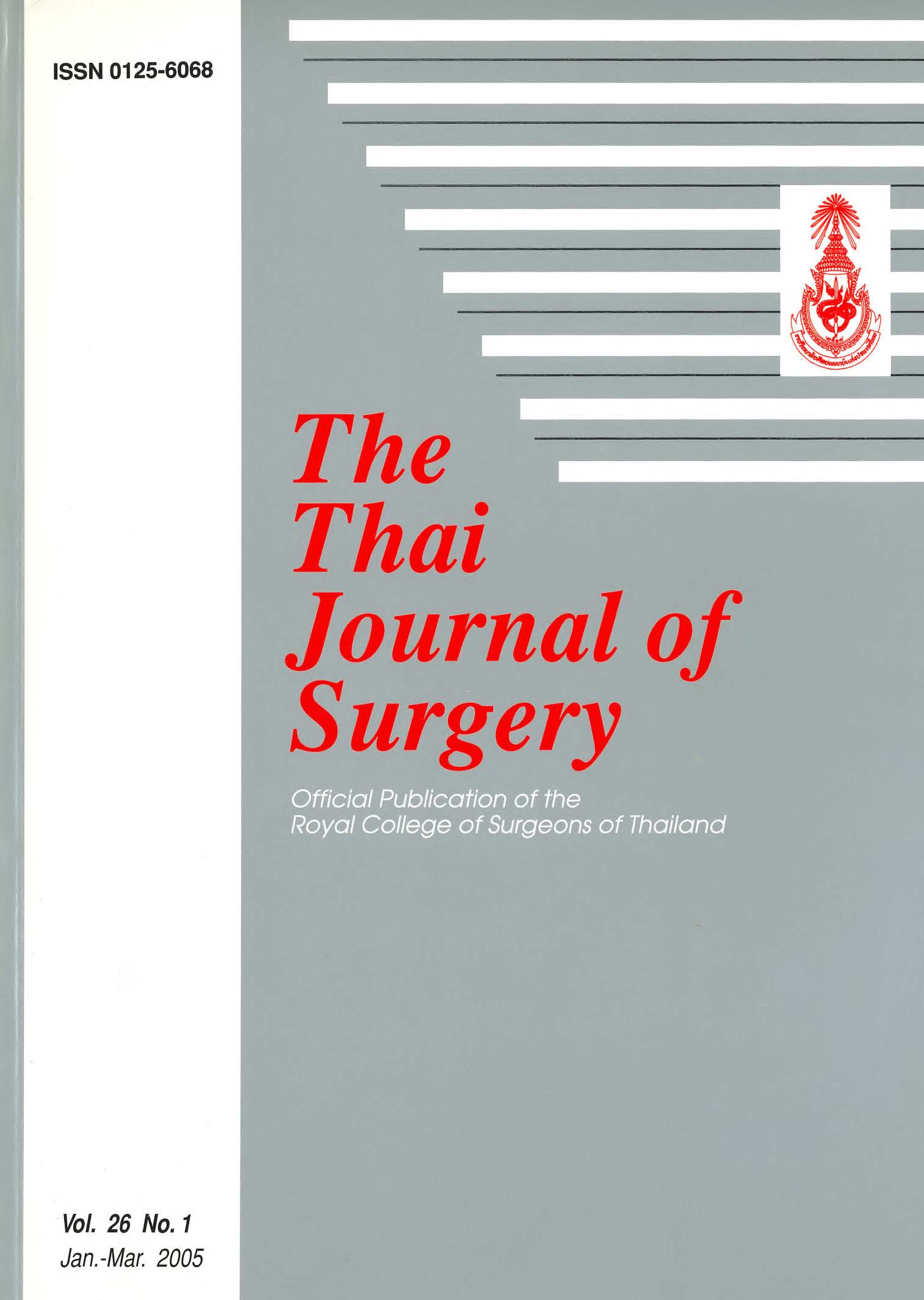The Accurate Depth of Drilling the Saw Bone with K-wire, Drill Bit and Steinmann Pin
Abstract
Objectives: The purposes of this study were to determine the accuracy of free-hand technique in utilizing various instruments and whether using a protective device to prevent over-penetration of the instrument would reduce the chance of injury to the adjacent soft tissue structures.
Materials and Methods: Forty orthopaedic residents at Siriraj Hospital were enrolled in this study. A 3.2 mm. drill bit, a 2.0 mm. K-wire, and Steinmann pin no.5 were inserted into an artificial saw bone with a cordless electric driver and stopped when they felt that the instrument had penetrated through the far cortex. The distance from the tip of the instrument to the far cortex of the saw bone was measured. This procedure was repeated 3 times. Then, with the same group of orthopaedic residents, the width of the saw bone was measured radiographically. The actual width of the saw bone was reduced by 10% due to the radiographic magnification. A protective device was then used to prevent the instrument from over-penetrating into the saw bone by adjusting the length of the protective device from the tip of the instrument according to the x-ray measurement. This experiment was repeated 3 times, data were collected, and mean values were calculated. The results from the 2 groups were compared by using paired t-test.
Results: The mean distances for the 3.2 mm. drill bit, 2.0 mm. K-wire, and Steinmann pin no.5 were 8.06 mm. (2.33 mm.-17.37 mm.), 5.09 mm. (1.33 mm.- 11 mm.), and 4.9 mm. (0.67 mm.-12 mm.) respectively in the free-hand technique group, and 1.42 mm. (0.33 mm.-3.33 mm.), 1.53 mm. (0.33 mm.-2.67 mm.), and 1.44 mm. (0.33 mm.-3.0 mm.) respectively in the protective device group. The differences were statistically significant between the 2 groups (p <0.001). There were 10 times out of 360 times of drilling that the protective device touched the near cortex of the saw bone before the instrument penetrated through the far cortex.
Conclusions: Our study indicated that the over-penetrated distances were longer in the free-hand technique group than in the protective device group. We recommend the use of any kind of protective device which would reduce over-penetration to prevent injury to the surrounding soft tissue.
References
2. Siegel A, Schulz F, Puschel K. Fatal pelvic vein injury caused by guide wire used with the dynamic hip screw. Unfallchirurg 2001;104:182-6.
3. Chelcron AJ, Mekhail AO, Ebraheim NA. Radial artery injury in association with fractures of the trapezium. J Hand Surg Br 1997;22:419-22.
4. Muller ME, Allgower M, Schneider R, Willenegger H. Manual of internal fixation: techniques recommended by the AO-ASIF group. 3rd ed. Berlin: Sprinter-Verlag; 1990.
5. George NW. General principles of fracture treatment. In: Canale ST, editor. Campbell's operative orthopaedic. 10th ed. Philadephia: Mosby; 2003. p. 2669-723.
6. Madhow A, Karunakar, Michael JB. Principles of external fixation. In: Bucholz RW, editor. Rockwood and Green's fractures in adults. 5th ed. Philadephia: Lippincott Williams and Wilkins, 2001. p. 231-41.
7. Lim EVA, Lavadia WT, Blebea J. Vascular impingement by external fixator pins: a case report. J trauma 1995; 38: 833-5.
8. Behren F, External skeletal fixation. Complications of external skeletal fixation. Instructional course lecture 1981; 30:178.
9. Green SA. Complications of external skeletal fixation. Clin Orthop 1983; 180: 109-16.
10. Slomka R. Complications of ring fixators in the foot and ankle. Clin Orthop 2001; 391: 115-22.
Downloads
Published
How to Cite
Issue
Section
License
Articles must be contributed solely to The Thai Journal of Surgery and when published become the property of the Royal College of Surgeons of Thailand. The Royal College of Surgeons of Thailand reserves copyright on all published materials and such materials may not be reproduced in any form without the written permission.



